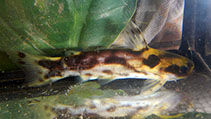| Family: |
Auchenipteridae (Driftwood catfishes), subfamily: Centromochlinae |
| Max. size: |
11.6 cm SL (male/unsexed) |
| Environment: |
benthopelagic; freshwater |
| Distribution: |
South America: Suriname and Marowijne River basins in Suriname; Maroni and Sinnamary River basins in French Guiana; Negro River drainage and at a single locality in Central Amazon basin in Brazil; Trombetas river drainage in Brazil. |
| Diagnosis: |
Dorsal spines (total): 1-1; Dorsal soft rays (total): 5-5; Anal soft rays: 10-11; Vertebrae: 34-36. Diagnosed from all other species of Tatia by the following characters: male anal fin with sharp pointed tip; the first unbranched anal-fin ray divided into 3-4 segments; and the last branched ray reduced. Can be distinguished from most of its congeners, except Tatia aulopygia Tatia intermedia and Tatia gyrina, by having a wide mouth, width 54.0-59.7% HL (vs. 39.0-53.3% HL). Additional characteristics for recognition of Tatia brunnea are diagnostic in combination: nasal ossified with wide medial flanges partially sutured to lateral margin of mesethmoid; ribs 9-10; post-Weberian vertebrae 34-36. Other features useful for distinguishing Tatia brunnea include details in coloration, such as: border of mouth whitish, contrasting with dark head; posterior border of nuchal shield usually whitish or pale; pectoral-fin spine usually with transverse bands; caudal fin usually whitish with scattered dark brown blotches; and head width 86.6-93.4% HL (Ref. 79512).
Description: Anal fin iii,7, rarely iii,8; Pelvic fin i5; post-Weberian vertebrae 34-36 (Ref. 79512). |
| Biology: |
Sympatric with Tatia intermedia in some rivers in Suriname and French Guiana and also in the Trombetas river (Ref. 79512). Rather rare, occurs in the slow parts of creeks. May easily be mistaken as juveniles of Glanidium leopardus with which it is distinguished by means of the pectoral spines (having projections vs. smooth) and by the number of rays in the anal fin (8-9 vs. 12-14). Sexual dimorphism in males appear at a length of 3.5-4.0 cm. Its small size makes it interesting for aquarists (Ref. 35381). Reported sizes at sexual maturity are above 5.46 cm SL and above 7.0 cm SL (Ref. 79512). |
| IUCN Red List Status: |
Least Concern (LC); Date assessed: 19 August 2020 Ref. (130435)
|
| Threat to humans: |
harmless |
Source and more info: www.fishbase.org. For personal, classroom, and other internal use only. Not for publication.

